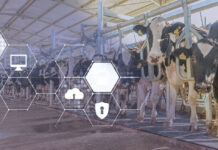Heat stress can decrease estrus cycles, decrease sperm counts
The stress of summer heat can negatively affect cattle in a variety of ways. The long stretches of hot, dry days can cause animals to eat less, gain fewer pounds and experience poor reproduction. For operations with spring calving herds, breeding season typically occurs during the searing days of summer leaving producers to figure out ways to mitigate the impact of the heat on breeding cycles.
Estrus Expression: Some animals will incur a decline in reproductive efficiency as a response to heat stress. “One of the biggest consequences is the reduced duration and intensity of estrus,” Maggie Justice, Ph.D., beef cattle extension specialist and assistant professor with the University of Arkansas Division of Agriculture, explained. “When a cow is under heat stress a decrease in her production of estradiol and luteinizing hormone (LH) can occur. This can strongly impact her estrus expression.”
Even when an animal is in estrus, she may not express it because of her body’s response to overheating. Additionally, Dr. Justice points out with an animal’s decrease in dry matter consumption, a negative energy balance can also occur, suppressing the reproduction process.
Bull Fertility: While heat stress can negatively impact heifers and cows, it can also affect the fertility of bulls. “Research has shown that sperm motility is reduced, and abnormal sperm count can be increased while the total sperm concentration can be reduced,” Justice stated. “For all animals the want to be active is suppressed in hot, dry conditions. This can alter breeding activity as well.”
Managing Heat Stress: Producers do not have the ability to change the weather, but they can implement management strategies to mitigate the negative effects of heat on their animals. Beef extension specialists recommend preplanning to equip cattle to handle the impact of heat more effectively.
One strategy is making sure animals are in their ideal body condition score (BCS) prior to the onset of the hot, summer days. “The ideal BCS for beef cattle going into the breeding season is considered to be between a 5 and 6. This can help to ensure that they can partition nutrients toward reproduction,” Justice said.
Pasture Management: Cattle coping with heat stress must utilize increased energy in order to maintain homeostasis. When animals are forced to tap into extra energy, they lose weight. This is especially the case when the heat stress is combined with a reduction in dry matter intake.
Extension specialists emphasize producers should pay particular attention to pasture management during these conditions. Justice recommends producers continually evaluate and adjust stocking rates to ensure animals do not run out of feed or have to compete for it. Another management strategy to consider is rotating to new pastures during the evenings. This practice encourages animals to actively graze as the daytime temperature decreases. Additionally, producers may want to consider feeding supplements during cooler times of the day.
Water and Shade Access: Make sure water troughs are full of fresh, clean water and the herd has ample space to gather around and drink. Additionally, provide access to shade and keep minerals available in the pastures. Lastly, schedule working cattle for the cooler times of day.




